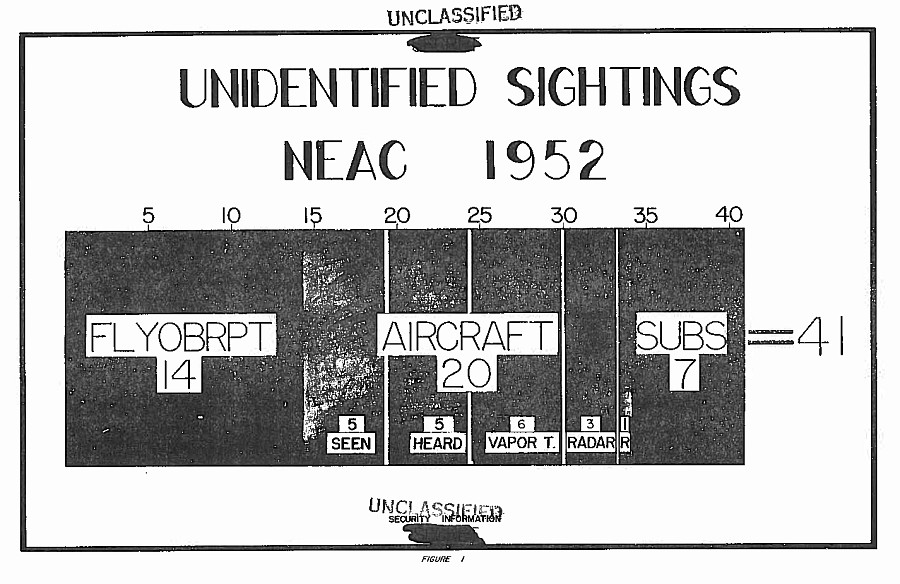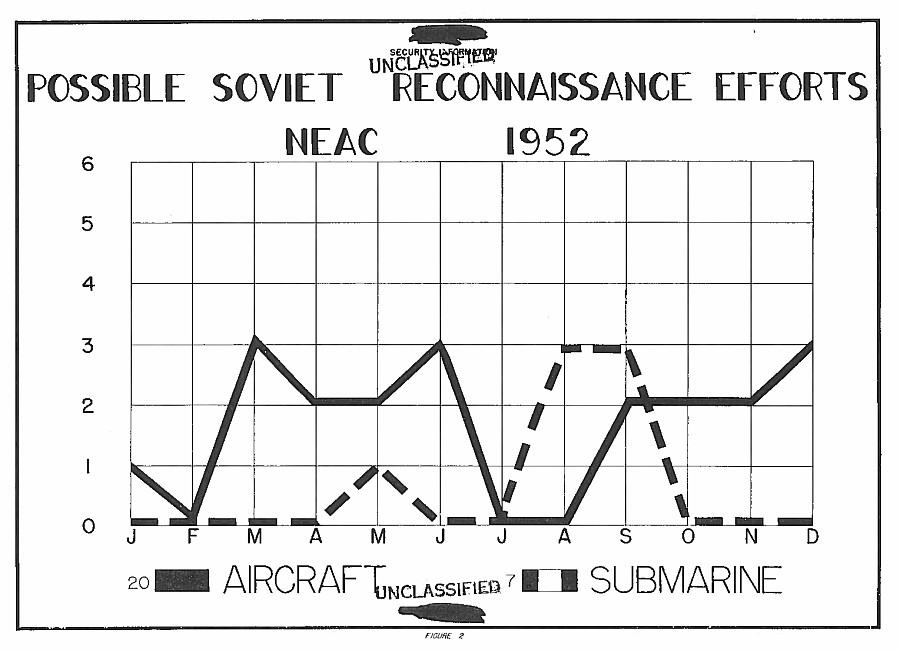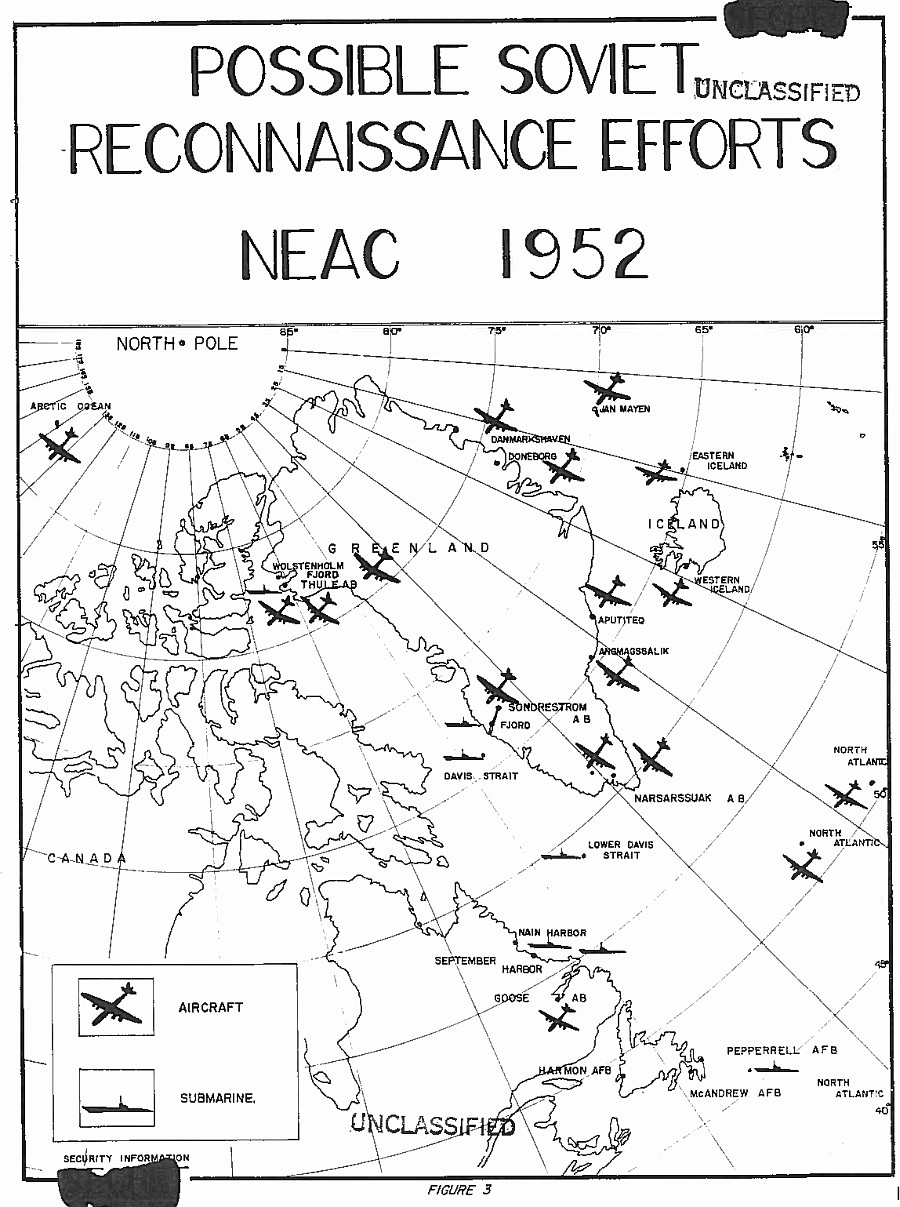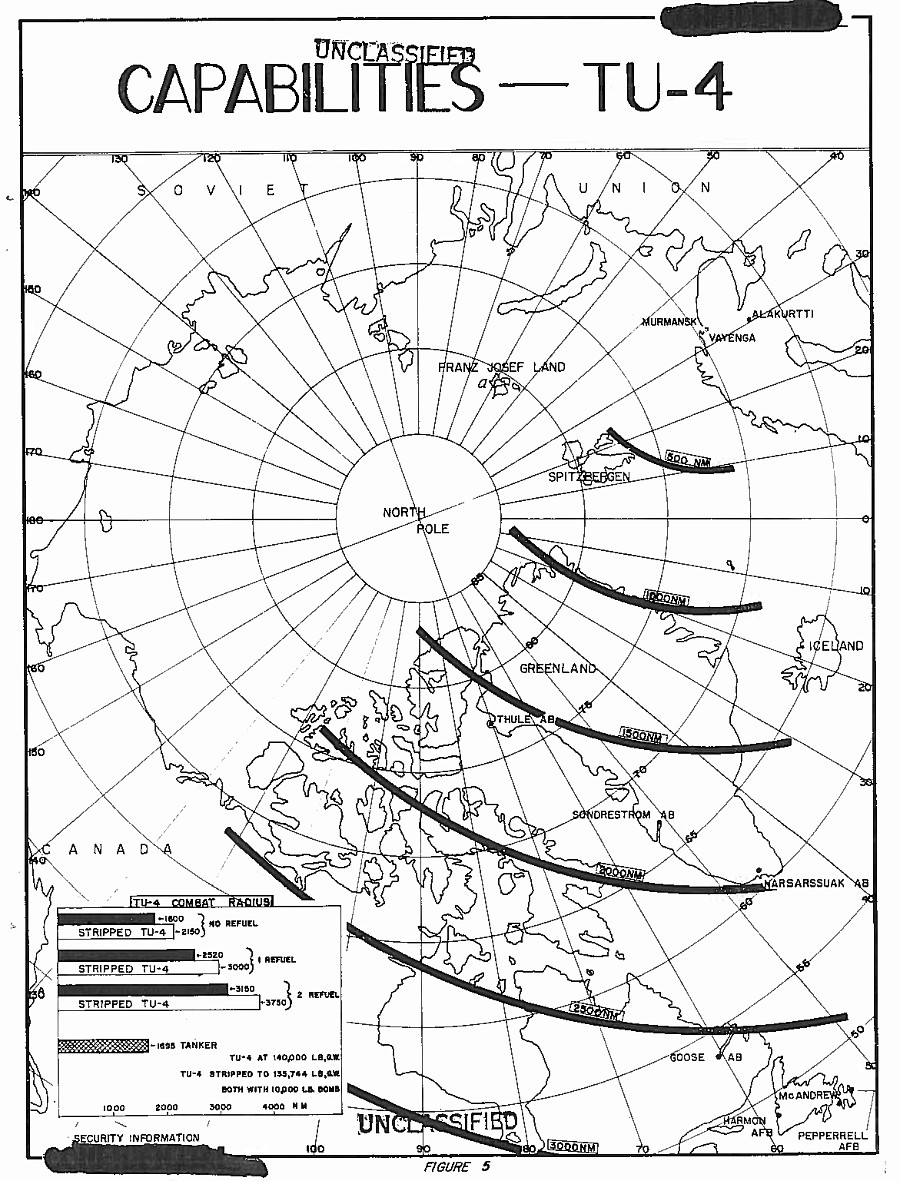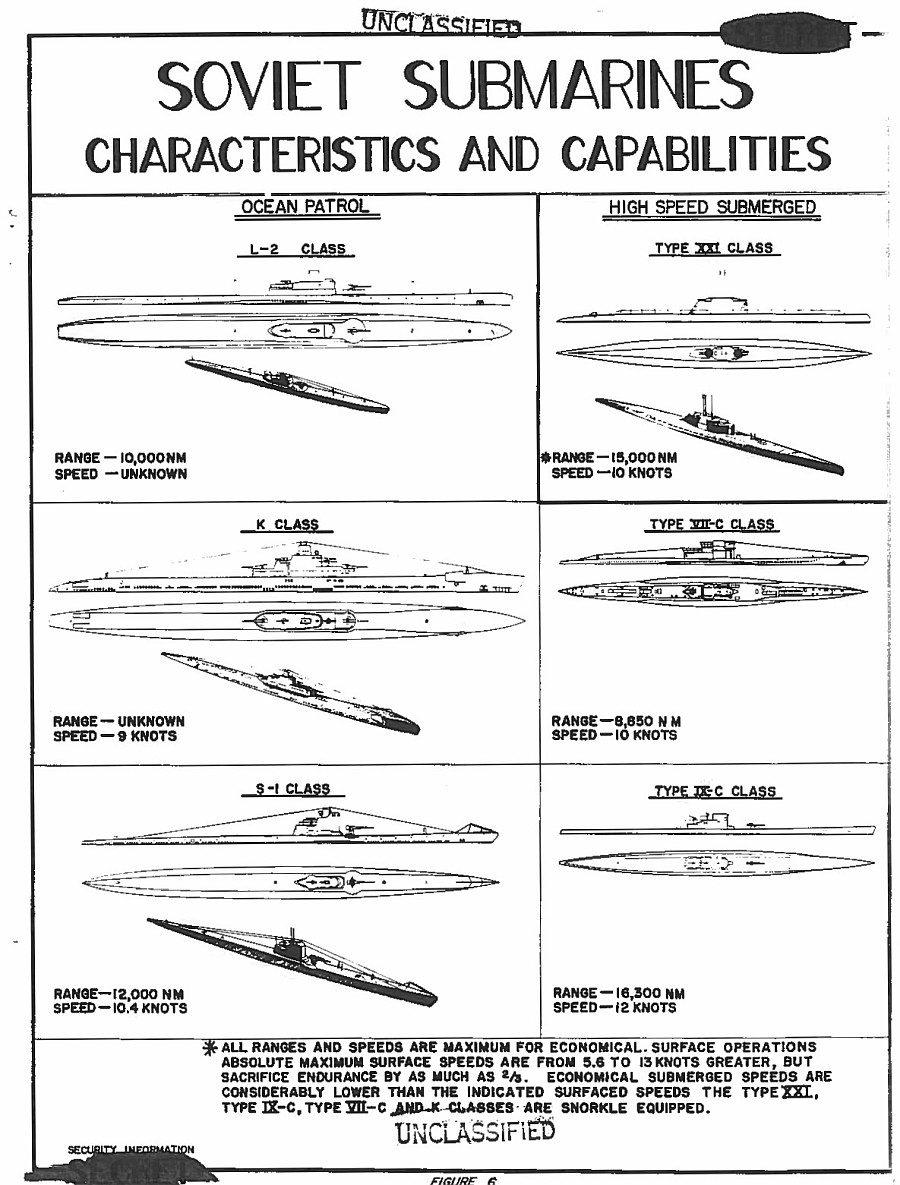SECURITY INFORMATION
VITAL INTELLIGENCE SIGHTINGS
NORTHEAST AIR COMMAND
| THIS DOCUMENT CONSISTS OF COVER PAGE, TITLE PAGE, PAGES I AND II, PAGES 1 THRU 13 AND BACK COVER. |
1 MARCH, 1953 THIS IS COPY NO.83 OF 154 COPIES |
WARNING! THIS DOCUMENT CONTAINS INFORMATION AFFECTING THE NATIONAL DEFENSE OF THE UNITED STATES WITHIN THE MEANING OF THE ESPIONAGE LAWS, TITLE 18 U.S.C., SECTION 793 AND 794. ITS TRANSMISSION OR THE REVELATION OF ITS CONTENTS IN ANY MANNER TO AN UNAUTHORIZED PERSON IS PROHIBITED BY LAW. |
| SECRET AUTH:_CG NEAC INITIALS: [initialed] DATE: 15 MAR 53 |
SPECIAL STUDY
53-1
ANALYSIS OF UNIDENTIFIED VITAL INTELLIGENCE SIGHTINGS
FOR THE YEAR 1952
Prepared by
DIRECTORATE OF INTELLIGENCE
HEADQUARTERS, NORTHEAST AIR COMMAND
APO 862, c/o PM, New York, N.Y.
This Study was prepared by the Director of Intelligence, Northeast Air Command and is an analysis of the unidentified vital Intelligence sightings which occurred within or adjacent to the Command area during the calendar year 1952.
The standard evaluation table given below has been used to evaluate each incident reported in this study. This evaluation reflects NEAC's estimation of the reliability of the source and the veracity of the information. The possibility that each incident represents a Soviet reconnaissance effort is reflected by this evaluation.
|
An "A" source rating was given in only two instances: first, when the base weather officer reported his own observations of contrails, and second, when a tower operator reported an unidentified voice contact. A "B" rating indicates an informant of known integrity. "C" "D" and "E" ratings indicate a proportionately decreasing degree of reliability. An "F" rating is assigned when nothing is known concerning the background or reliability of the observer.
The numerical ratings for items of information are independent and distinct from the letter ratings listed for the sources, since it is quite possible for a reliable source to submit a report of which the truth cannot be judged (A-6), or an unreliable source to submit a report which is probably true or confirmed by other sources (F-1).
 FRED W. SIEBERT Lt. Colonel, USAF Director of Intelligence |
i
HEADQUARTERS
NORTHEAST AIR COMMAND
| NEAC SPECIAL STUDY 53-1 | 15 March 1953 |
| TABLE OF CONTENTS | Page |
| Foreword | 1 |
| I Problem | 1 |
| II Facts Bearing on the Problem | 1 |
| A. General | 1 |
| B. Flying Objects | 1 |
| C. Possible Soviet Reconnaissance Patrols | 2 |
| D. Unidentified Aircraft | 2 |
| E. Unidentified Submarines | 3 |
| III Discussion | 4 |
| IV Conclusions | 5 |
| A. 1952 Sightings | 5 |
| B. Future Sightings | 6 |
| Appendix | 7 |
| Figure 1 - Unidentified Sightings NEAC 1952 | 8 |
| Figure 2 - Possible Soviet Reconnaissance Efforts NEAC 1952 |
9 |
| Figure 3 - Possible Soviet Reconnaissance Efforts NEAC 1952 (Map) |
10 |
| Figure 4 - Tabulated List of Unidentified Sightings NEAC 1952 |
11 |
| Figure 5 - Capabilities of the TU-4 | 12 |
| Figure 6 - Soviet Submarines, Characteristics and Capabilities |
13 |
| DISTRIBUTION | - See inside back cover |
ii
I PROBLEM
To present an analysis of unidentified vital Intelligence sightings which occurred within or adjacent to the Northeast Air Command area during the calendar year 1952.
II FACTS BEARING ON THE PROBLEM
A. GENERAL
During the year 1952, the Director of Intelligence, NEAC received 46 reports of unidentified sightings. Of this number, five (4 aircraft and 1 submarine) were later identified as friendly. This left a total of 41 incidents still unidentified and needing further evaluation, (see Figure l).
B. Flying Objects
Of this number, 14 by their very nature, could not be considered to have been caused by conventional aircraft or vessels. The reports in this category consisted primarily of unidentified aerial lights or flying objects. These incidents are not peculiar to the Northeast Air Command, as similar sightings are being reported from other areas of the world. While no satisfactory explanation has been established to explain all of these phenomena, each case is carefully studied and forwarded by expeditious means to the Air Technical Intelligence Center at Wright-Patterson Air Force Base. As yet, no evidence has been forthcoming from the NEAC area to prove that these phenomena represent a threat to the security of the United States.
1
C. POSSIBLE SOVIET RECONNAISSANCE PATROLS
By thus eliminating from further discussion incidents in the flying object category and those which have been identified, a core of reports remain numbering 27 which do appear to be indicative of human activity, but which cannot be readily attributed to operations known to the Northeast Air Command.
It is with this category that we are primarily concerned. Twenty of these incidents concerned unidentified aircraft, and seven represented unidentified submarines. (See Figures 2 and 3)
D. UNIDENTIFIED AIRCRAFT
Of the aircraft which were reported and have not been identified, only five were actually seen as aircraft by the naked eye. These aircraft were sighted at the following locations: (See Figure 3)
Eastern Iceland - 6700N/1350W
Doneborg, Greenland - 7410N/2030W
Thule Air Base, Greenland - 75 miles south - 7520N/6910W
North Atlantic - 5200N/2820W
Arctic Ocean - Ptarmigan route - 8304N/l5100W
Five unidentified aircraft were heard in the darkness or overcast, passing over or near the following locations:
Danmarkshaven, Greenland - 7646N/1845W
Aputitec, Greenland - 6755N/3215W
Angmagssalik, Greenland - 6530N/3733W
Jan Mayen Island - 7110N/0720W
Sondrestrom Air Base, Greenland - 6701N/5044W
2
Vapor trails were reported on six separate occasions over or near NEAC bases:
Thule Air Base, Greenland - twice - 7630N/6848W
Goose Air Base, Labrador - twice - 5319N/6025W
Narsarssuak Air Base, Greenland - 6140N/4610W
Between Sondrestrom Air Base and Narsarssuak Air Base - 6254N/4650W
An unusual radio contact with an unidentified aircraft was reported by the Iceland Defense Force - 6401N/2204W.
Further data on these aircraft sightings is tabulated in Figure 4.
It is significant to note that each of these areas reporting unidentified aircraft is within range of round trip missions by Soviet TU-4s operating from air facilities on the Kola Peninsula, (See Figure 5). All NEAC bases except those on the island of Newfoundland reported evidence of at least one unidentified aircraft during 1952.
Four additional aircraft sightings were reported in 1952 but were identified as friendly.
E. UNIDENTIFIED SUBMARINES
Submarine sightings during the year totaled eight, but one was later identified as a US Navy submarine. The remaining seven were reported by different sources of varying credibility. Two were sighted by Eskimoes (sic), two were visually observed by personnel aboard aircraft in flight, one was observed by airborne radar, one by Royal
3
Canadian Mounted Police, and one by a Danish police officer in a surface craft. The location of these sightings is as follows: (See Figure 3)
North Atlantic - 4261N/5005W
September Harbor, Labrador - 5633N/6143W
Main Harbor, Labrador - 5634N/6142W
Lower Davis Strait - 5730N/5300W
Wolstenholm Fjord, Greenland - Thule area - 7637N/6944W
Sondre Stromfjord, Greenland - 6640N/5150W
Davis Strait - 6600N/5500W
Further data on these submarine sightings is tabulated in Figure 4.
The Soviet Union has an estimated 101 high speed submerged and ocean patrol submarines which are capable of penetrating all areas of the Northeast Air Command (See Figure 6). In addition, an estimated 89 Soviet submarines of medium range could operate along Greenland's East Coast. By refueling at Spitzbergen or from the Russian fishing fleet positioned near Iceland, the range of these ships could be greatly extended.
III DISCUSSION
Turning now to a chronological analysis of these sightings, it is at once evident by a glance at the chart on Figure 2 that these sightings were not limited to any particular season of the year. It would appear, however, that spring (March, April, May and June) and fall (September, October, November and December) represent the peak periods of unidentified aerial activity. The chronological sequence of these aircraft sightings is listed in Fugure (sic) 4.
4
It is significant to note that during the peak of NEAC activity - July and August, the months of optimum daylight - that no unidentified aircraft were reported. This fact lends strength to the possibility that the other reported incidents do represent enemy reconnaissance efforts, as the Soviets would be less likely to conduct aerial reconnaissance during the Arctic summer when the chances of being detected would be the greatest.
Another interesting factor is that during this lull in aircraft reporting, submarine sightings suddenly multiplied (See Figure 2). With the exception of a single possible submarine sighting in May, all of these incidents occurred within a 33 day period during August and September. The progression of these submarine sightings chronologically presents an interesting picture of possible Soviet reconnaissance patrols (See Figure 4).
IV CONCLUSIONS
A. 1952 SIGHTINGS
The sightings which have been the subject of this study reflect only possible Soviet reconnaissance patrols which have been detected. For each sighting which was reported, an undetermined number of aircraft and submarines could have come and departed completely undetected, because of the vast areas within the Northeast Air Command which are unpopulated and, as yet, unpatrolled.
5
B. FUTURE SIGHTINGS
Reports of unidentified sightings can be expected to continue on an increasing basis. There are indications that the Communist world is becoming increasingly apprehensive about the intentions of the new United States administration. This apprehension should tend to increase Soviet reconnaissance activity. Although it is admitted that some of these incidents are based on inconclusive and unconfirmed evidence to positively identify them as representative of Soviet activity, judging from the pattern established in 1952, it is to be expected that this unidentified air activity will increase as Spring approaches.
6
